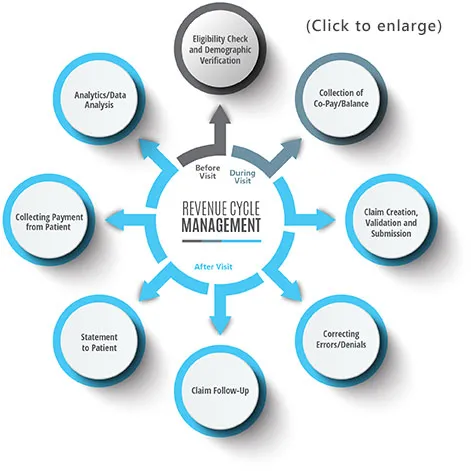Medical Revenue Cycles are responsible for bridging the gap between effectively reimbursing physicians for their care and elevating patients’ experiences from check-in to bill-pay. Medical bills must be accurate, compliant with regulations, and timely to ensure that patients receive proper care and that medical facilities receive adequate reimbursement. Unfortunately, several key issues can arise when it comes to medical billing in revenue cycle management (RCM) processes, negatively impacting efficiency, accuracy, and patient satisfaction.
1. Siloed Steps in Your Revenue Cycle Process
30% of hospitals use two or more RCM vendors, while almost an equal percentage of hospitals and health systems have an internal team dedicated to RCM automation. Finance leaders polled through the Healthcare Financial Management Association's (HFMA) Pulse Survey program for Alpha Health report nearly 20 percent use two vendors with one handling multiple parts of the automation process, while about 5 percent use three vendors that each handle a different aspect and 5 percent use four or more vendors to fully manage revenue cycle automation. In addition to the confusion of managing multiple vendors, some organizations overlook duplicate features available in their current software.
How to Improve: We recommend auditing your current RCM services. Look for opportunities to integrate systems, enabling procedures/visits/tests to be accurately communicated with your billing management software. With an all-in-one RCM system, this then delivers data to clearinghouse, patient payment portal, statement vendor, electronic health records (EHRs), and reporting systems. This communication helps increase collection speed and accuracy, in addition to reducing time in Accounts Receivable (A/R), resulting in improved performance for both providers and patients.
2. Backed-up Medical Billing Workflow During Admission and After a Patient’s Visit
Manual processes and time-consuming paperwork during patient admission and/or after a patient’s visit are two of the largest bottlenecks within the medical billing process. Inefficiencies can also lead to inaccurate data, decreased patient experience, and poor claims management.
How to Improve: Switching from paper statements to electronic statements (e-statements) provides greater efficiency, while still giving patients who prefer paper statements the option to receive one. We recommend auditing who is receiving paper statements, in case patient requests change over time.
3. Denied and Rejected Claims Management
Average claim denial rates range from 6-13 percent, and 65 percent are never resubmitted. An estimated 90 percent of denials are preventable. Common causes of claim denials include missing or incorrect data, duplicate or late submissions, improper or outdated CPT or ICD-10 codes and lack of documentation or prior authorization.
How to Improve: We recommend employing a three-pronged strategy, involving insurance verification and eligibility optimization; training staff on crucial conversations regarding payments obligations; and transitioning to better IT software that reduces delays between filing claims and patient billing.
4. Adapting to Changes in ICD Codes
There are over five times the number of medical diagnosis codes in ICD-10, 68,000 in 2023, compared to 13,000 in ICD-9. Traditionally, adapting to changing ICD codes relied entirely on continual training and tribal knowledge – which became trivial with staffing challenges, mass retirements, and additional overhead.
How to Improve: Utilizing automated coding and machine learning software offers an effective solution, learning from past diagnosis codes compared with their rate of successful claim submissions while also auto-populating new claims with relevant information for quicker reimbursement processing times.
5. Revenue Data Loss, and a Lack of Healthcare Analytics
RCM processes experience tremendous roadblocks from inadequate healthcare analytics, leading to the inability to make data-driven decisions.
How to Improve: We recommend leveraging business intelligence tools, delivering data integration, real-time reporting, and customizable dashboards. Learn more about ImagineSoftware’s medical billing reports, analytics, and healthcare business intelligence here.
Current Revenue Cycle Management Workflow
The RCM workflow from beginning to end consists of the following eight medical billing cycle steps:

Step 1: Eligibility Check and Demographic Verification: Ensuring patients have valid insurance coverage prior to scheduling an appointment.
Step 2: Collection of Co-pay/Balance: Collecting a fixed amount from a patient at time of service as well as the amount owed from a prior visit that wasn’t covered by a patient’s insurance.
Step 3: Claim Creation, Validation and Submission: Manually or electronically creating claims and submitting them to the insurance provider, a clearinghouse or another type of claims vendor.
Step 4: Correcting Errors/Denials: Determining if a claim needs to be corrected and resubmitted or if additional documentation is required. Some insurance providers also have a specific appeal process, deadlines or a timely filing limit you must meet to be successfully reconsidered.
Step 5: Claim Follow-up: Reaching out again to the payer via phone, email, letter or online. When done correctly, following up can substantially reduce days in A/R and ease unnecessary financial burden on patients.
Step 6: Statement to Patient: Sending the final costs to a patient as a printed or electronic bill, including demographic details, the amount owed, date of the procedure and transaction descriptions.
Step 7: Collecting Payment from Patient: Mobile and online payment are two methods used today to simplify patient collections. It’s important to consider the needs of your staff to fulfill basic requirements, such as automatic posting and reconciliation.
Step 8: Analytics/Data Analysis: Processing and aggregating data into meaningful insights to improve business operations in the form of increased collections, reduced days in A/R and stable financial performance.
At ImagineSoftware, we offer intelligent multi-specialty medical billing software solutions such as ImagineBilling™ that simplify complex billing processes, automate charge claim management, and monitor productivity levels all while ensuring compliance with regulations at every step along the way – contact us today for more information!